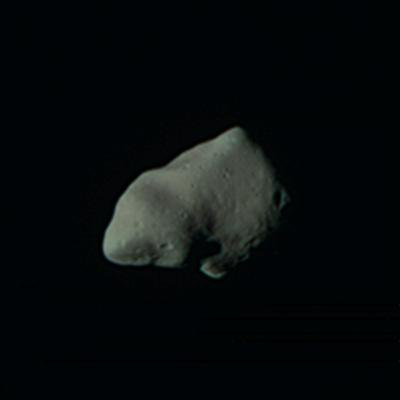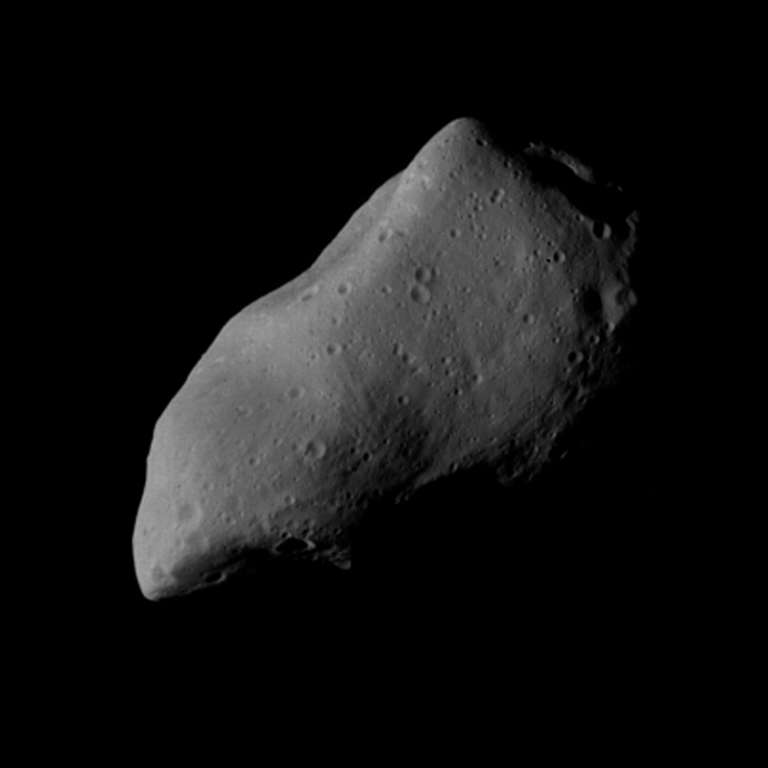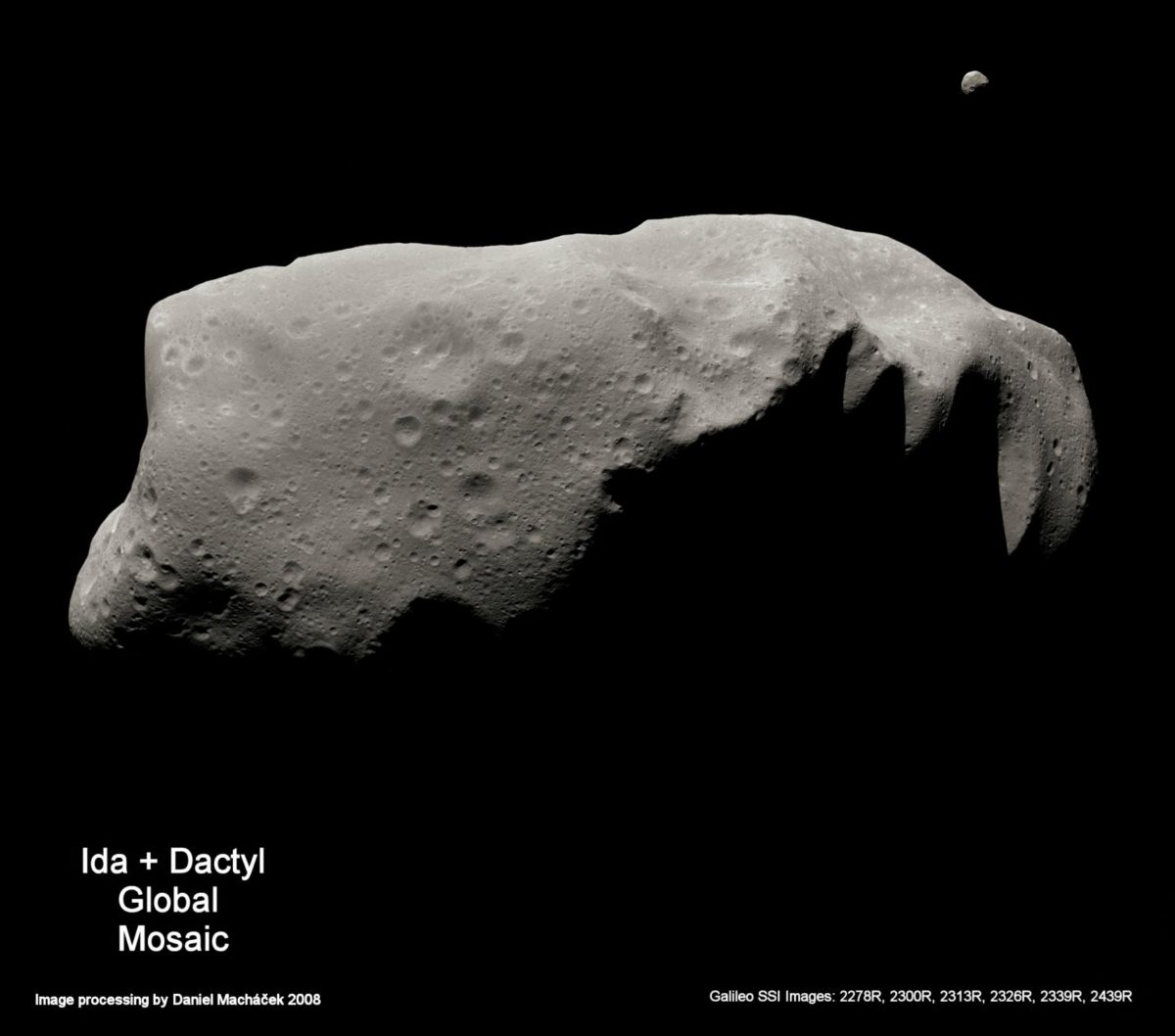Emily Lakdawalla • Feb 05, 2013
Galileo Messengers: Cruise to Venus, Earth, Gaspra, Earth, Ida, and almost to Jupiter
Almost exactly a year ago now, I wrote a post about the Galileo Messengers, newsletters that the Jet Propulsion Laboratory published a few times a year about the Galileo Jupiter mission. That post only covered the first 21 issues, which spanned the painfully long and dramatic period from mid-1981 up until "Launch at Last!" on October 18, 1989. It's taken me this long to read and then write about the mission's next phase -- cruise -- because I was dreading the contents of those issues of the Messenger. I knew that, at least at first, I would be reading jubilant updates from people who had no idea of the terrible problem they would eventually discover: that Galileo's deployable high-gain antenna (HGA) was not, in fact, deployable. It was too painful to face.
But this week, in response to a journalist's inquiry about the rest of the Messengers, I finally steeled myself and read issues 22 through 37, covering the time from launch to just before orbit insertion in September, 1995. You can download them all through this page. Here is the story they tell.
Issue 22 (February 1990) covered preparations for the Venus flyby. So far, the news was good; the instruments had checked out successfully, trajectory correction maneuvers performed well. At time of print, though, the spacecraft was in safe mode, with no explanation offered. As of Issue 23 (April 1990) the flyby had been very successful. That issue also contained a farewell note from erstwhile project manager Richard Spehalski, who departed to work on the mission that would become Spitzer; the rest of the cruise-phase "From the Project Manager" columns were written by his successor, Bill O'Neil.
Issue 24 (July 1990) contained the first word of two problems that would never be completely resolved through the rest of Galileo's existence; they would only be understood and coped with. Both of them (probably) had the same root cause: debris causing transient electrical shorts in a crucial part of the spacecraft called the Spin Bearing Assembly.
You see, Galileo was a spacecraft with a split personality. The part of the spacecraft that held the fields and particles instruments spun constantly, like the Pioneer spacecraft. The part of the ship that held the cameras and other optical instruments could spin, but when it needed to point to take photos and such, it had to be despun and held steady. So the spacecraft was kind of like a Pioneer stacked on a Voyager, with a spun (Pioneer-like) section and a despun (Voyager-like) section. The two were connected with a freely rotating joint, the Spin Bearing Assembly. Of course, Galileo wasn't really just two distinct spacecraft mated together; power and data had to be passed back and forth between the spun and despun sections all the time. That happened through electrical connections between slip rings and brushes in the Spin Bearing Assembly. And debris created by wear of the brushes caused transient electrical shorts between the slip rings.
The first problem was the "AC/DC bus imbalance." There were both AC and DC power systems passing power across the spin bearing assembly, and the electrical shorts caused voltage fluctuations. The rest of the Galileo Messengers contain reports on the voltages of the imbalance measurements. Once this problem was finally well-understood more than a year later, it was apparently considered only a minor annoyance, especially in the context of everything else that happened to Galileo.
The second problem was a more serious one. A transient short caused the spacecraft to think that the main computer in the despun section of the spacecraft had rebooted, even though it had not. In response to this spurious signal, the spacecraft went into safe mode, which means that it stopped operating according to the program it had been given, and instead hunkered down and waited for further instruction from Earth. These events were called "spurious Command Data Subsystem (CDS) power-on reset (POR) telemetry indications." These happened unpredictably more than 20 times throughout the cruise period. Sometimes they happened at particularly bad times -- like twice in the month before the Ida flyby. It was only shortly before Jupiter orbit insertion that they had finally developed software that could detect when these signals were spurious and prevent the spacecraft from safing.
Issue 24 also contains a great explanation of so-called single-event upsets, when heavy ions moving at relativistic speeds cause a single bit to flip in the computer's memory. Galileo was well-shielded from this kind of problem, and didn't suffer one throughout cruise. They happened with a vengeance, though, later in the mission, when Galileo dipped into Jupiter's nasty radiation environment. But that's a story for another day.
Issue 25 is notable mostly for this great line from Torrence Johnson: "Chairing the Project Science Group is a real challenge. Dr. 'Robby' Vogt, former JPL Chief Scientist and an early Voyager PI, once likened the job to organizing a school of barracuda." Issue 26 described a fairly routine phase of cruise. Issue 27, from April 1991, was a "special issue" devoted to the first Earth-Moon flyby -- the first Earth gravity assist flyby by a NASA spacecraft. (The first-ever one was performed by Giotto, as was pointed out to me on Twitter.) Returning to Earth has now become a common operation for interplanetary spacecraft; I'd forgotten Galileo pioneered the Earth gravity-assist maneuver. Following the flyby, Galileo captured an amazing sequence of photos over a period of 25 hours as Earth receded from view. Here is just a small subset of those photos, in a version processed by Doug Ellison:
Issue 28, from August 1991, was when the hammer finally fell. They'd had to wait until after the first Earth flyby to deploy the umbrella-like high-gain antenna because the antenna had not been designed to handle the hot environment of the solar system inside Earth's orbit. This design was a legacy of the time when Galileo was to have been launched on a direct-to-Jupiter trajectory from the Space Shuttle. After the Challenger disaster, they had to go to a VEEGA trajectory -- Venus-Earth-Earth Gravity Assist -- which would take them, obviously, to Venus' distance from the Sun.
Until the first Earth flyby, the antenna had to stay furled, hidden behind a sunshade. So it wasn't until right after the Earth flyby that they discovered that it wouldn't, in fact, unfurl. The issue contains a detailed analysis of the nature of the problem. They knew so much about it right away, it seemed impossible that they wouldn't find a fix. They never did, though, despite years of effort.
While they publicly expressed confidence that the antenna problem would be solved, they were already coming to terms with the fact that they'd need to replan the flyby of Gaspra -- which would be the first-ever spacecraft flyby of an asteroid -- to take place without the benefit of the high-gain antenna. And there was a little good news: they were beginning to understand that the AC/DC bus imbalance and spurious power-on reset signal problems were related to slip-ring brush debris.
Issue 29 -- February 1992 -- featured a single image of Gaspra taken during the October 29, 1991 flyby. It wasn't the highest-resolution view Galileo got; it was one precious photo selected from a time in the encounter that they were 95% confident, based on their best estimate of where the asteroid actually was, that the image would contain the asteroid. At their low data rate, they couldn't relay all the data right away, and the computer had no way of checking which images contained the asteroid, so they had to guess. Fortunately, their pointing was awesome, and they nailed it. The Venus encounter had been cool, but this was really the first publicly awesome accomplishment of Galileo -- the first-ever closeup view of an asteroid.

They still expressed a heartbreaking confidence that the antenna problem would besolved. "At [40 bits per second], approximately 72 hours are required to transmit a full, 800-line imaging frame....once the HGA is open, the time to transmit one full, 800-line image will be just one minute." Sigh. This issue also described a new anomaly, "CDS lock change events."
By Issue 30, in September 1992, they had given up hope on the first solution they had developed for the high-gain antenna problem. They described a new kind of effort, "hammering" the stuck ribs, which they'd eventually do thousands of times without effect. But they had begun to face the possibility of a Jupiter mission without the antenna, estimating that they could achieve 70% of their hoped-for science (including 100% of the Probe mission). "An HGA technical workshop was held at JPL in June....Members included experts from the aerospace industry, other NASA centers, universities, the European Space Agency, and Department of Defense facilities. No new ideas were offered and no flaws were identified in the JPL problem assessment or action plan."
They had downlinked the highest-res view of Gaspra (actually a two-image mosaic), but much more data still remained aboard the spacecraft, awaiting transmission at a time when Galileo had approached closer to Earth.

Issue 31, published in February 1993 following the second Earth flyby, contained the sad admission that "We have not been able to free the stuck ribs of the High-Gain Antenna and there is no longer any significant prospect of deploying the HGA."
And yet, I also feel that this is the point when the tone of the mission began to shift. I may be projecting based on hindsight, of course. But the newsletters begin to feel more exuberant. Bill O'Neil wrote: "On to Jupiter! VEEGA is complete. The sole purpose of our 3.2-year VEEGA trip -- over twice around the inner solar system and 10 months in the asteroid belt -- was to get Galileo onto a direct Earth-to-Jupiter trajectory. Did we ever!" Unlike what felt like false bravado in earlier issues, it was as though a corner had been turned. I guess, with the gravity assist, it had!
It helped that there was cool science on that second Earth flyby -- for example, the first infrared imaging of north pole of Moon. O'Neil went on: "Galileo's images of the Moon are similar in resolution to the pictures the Voyager spacecraft took of Jupiter's moons. However, when Galileo reaches Jupiter, it will be ten, a hundred, even a thousand times closer to Jupiter's moons than Voyager was. This means that Galileo's images of the Jovian moons will have a resolution up to a thousand times better than that seen in these pictures of our Moon." They also confirmed a previous Galileo discovery, south polar stratospheric clouds that affected the ozone hole; and they finally downlinked all the Gaspra data.

That's not to say that Galileo's problems were over. The spurious power-on-reset signals had disappeared for a while, but they started recurring just in time for the August 28, 1993 asteroid Ida encounter, as reported in Issue 32, published in September. And a new anomaly cropped up in a previously well-behaved system, the attitude control system. And just to pile on, Mars Observer was lost just a week before the flyby, which, in addition to being awful and scary, dramatically reduced the Galileo mission's access to the big antennas of the Deep Space Network. Really, this Messenger contained so much drama, it deserves its own blog entry. I literally LOL'ed when I read this concluding sentence from O'Neil: "In summary, the Ida encounter took much, much more Flight Team effort than originally planned." But finally, all of that effort and struggle was paying off in the form of science results. On the front page they showed a spectacular five-image mosaic of Ida.
As of Issue 33, published February 1994, planning for performing the Jupiter mission without the high-gain antenna was going forward. The attitude control system problem was still not understood, and they were surprised by a spurious power-on reset signal that happened when the spacecraft was in all-spin mode, which didn't make any sense at the time, though it did later. But they were getting closer and closer to Jupiter. And a comet had just been discovered to be on a collision course with Jupiter -- Shoemaker-Levy 9 -- and Galileo's would be the only cameras in the solar system capable of watching the impacts as they happened. For once, a happy unexpected event! Bill O'Neil said: "The momentum is exhilarating!"
Amazingly, it wasn't until Issue 34, published in June 1994, that we made the surprising and wonderful discovery that Ida -- now far, far behind Galileo -- had a moon. It had taken almost a year to downlink all the Ida data, and the tiny thing had hidden until the end; it was finally discovered by imaging team member Ann Harch. The Messenger invited readers to suggest names for it, and the next issue contained that new name, Dactyl, proposed by Phil Stooke. This issue also marks the first mention of the availability of mission information via the Internet.

Issue 35, published December 1994, one year from arrival, contained really cool detail on strategies they had developed to maximize Shoemaker-Levy 9 observations while minimizing data volume, and photos of the results. It had a detailed explanation of how they solved for Dactyl's orbit and Ida's density -- more terrific new science. The issue also mentioned a new agreement with CSIRO, who had begun modifying the 64-meter Parkes antenna, expanding it to 70 meters, to help improve Galileo mission data return.
As of Issue 36 they were barreling down on Jupiter, and making final preparations. These included the first in-flight "brain transplant" for a planetary spacecraft. Galileo's flight software had had to be rewritten to be able to accomplish the mission without the high-gain antenna; in particular, the Probe mission data would've been lost without this flight software update. It was a stressful operation but for once something on Galileo worked without a major problem.
Issue 37 was the last before orbit insertion. Things finally seemed on the up and up. The Probe release was successful. There was a detailed preview of arrival plans, including the amazing science they planned at Io. The "Orbiter Deflection Maneuver" -- which targeted Galileo away from a Jupiter impact trajectory -- was successful. This was the first major use of their big 400-Newton engine. A major use of this engine was something they'd been jittery about since the loss of Mars Observer. There was no reason to suspect that Galileo could suffer the same anomaly that befell Mars Observer -- the two spacecraft bore few similarities -- but still, it was a major relief when that hurdle was successfully behind them.
They didn't know yet that just weeks before orbit insertion, they'd suffer a frightening anomaly on the reel-to-reel tape system that was an irreplaceable part of their strategy to accomplish the Jupiter mission without the high-gain antenna. But that's a story I'll save for another day, when I'll summarize the prime-mission Galileo Messengers. What an emotionally exhausting mission!
I want to thank Patrick Wiggins again for his scanning these newsletters for me. Go read them for yourselves.
The Time is Now.
As a Planetary Defender, you’re part of our mission to decrease the risk of Earth being hit by an asteroid or comet.
Donate Today

 Explore Worlds
Explore Worlds Find Life
Find Life Defend Earth
Defend Earth


